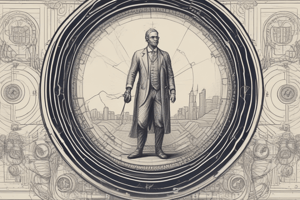Podcast
Questions and Answers
What does 10-1 mean?
What does 10-1 mean?
- Reception good
- Message received
- Reception poor (correct)
- Out of service
What does 10-2 mean?
What does 10-2 mean?
- Off duty
- Message received
- Reception good (correct)
- Relay message
What does 10-4 mean?
What does 10-4 mean?
- Provide escort
- Reception poor
- Message received (correct)
- Stand by
What does 10-5 mean?
What does 10-5 mean?
What does 10-7 mean?
What does 10-7 mean?
What does 10-8 mean?
What does 10-8 mean?
What does 10-13 mean?
What does 10-13 mean?
What does 10-19 mean?
What does 10-19 mean?
What does 10-35 mean?
What does 10-35 mean?
What does Code 3 mean?
What does Code 3 mean?
10-21 means telephone _____________.
10-21 means telephone _____________.
11-10 means take __________.
11-10 means take __________.
What does 11-81 mean?
What does 11-81 mean?
What does 11-99 mean?
What does 11-99 mean?
Flashcards are hidden until you start studying
Study Notes
CHP Code Definitions
- 10-1: Indicates poor reception of communications.
- 10-2: Signifies good reception.
- 10-4: Acknowledges that the message has been received.
- 10-5: Instructions to relay a message.
- 10-6: Notifies that the unit is busy and requests a stand-by.
- 10-7: Denotes that the unit is out of service.
- 10-8: Indicates that the unit is in service.
- 10-9: Requests the transmission to be repeated.
- 10-10: Signifies that the officer is off duty.
- 10-11: Identifies mobile frequency, KA4993 ("S" Channel).
- 10-13: Requests an update on road or weather conditions.
- 10-14: To provide an escort for an individual or vehicle.
- 10-15: Represents a prisoner in custody.
- 10-17: Instructions to relay papers, supplies, etc.
- 10-19: Directs to return to a specified location.
- 10-20: Requests the location of an officer or unit.
- 10-21: Instructions to make a telephone call.
- 10-22: Asks to disregard the message or assignment.
- 10-23: Indicates a request for a stand-by situation.
- 10-28: Requests vehicle registration details.
- 10-29: Checks for wants on a person, vehicle, or object.
- 10-30: Indicates improper radio traffic.
- 10-31: Refers to a suicidal subject.
- 10-35: Urgent signal that an officer needs backup with a suspect present.
- 10-36: Alerts that confidential information is being conveyed.
- 10-36A: Indicates confidential info with a possibly armed subject.
- 10-36F: Relates to confidential info regarding possible felony wants.
- 10-36M: Confirms information about possible misdemeanor wants.
- 10-37: Asks for the current time.
- 10-39: Signifies that a message or item has been delivered.
- 10-97: Indicates arrival at the scene.
- 10-98: Marks completion of an assignment.
Additional Codes
- 11-10: Signifies to take a report.
- 11-24: Relates to an abandoned vehicle.
- 11-25: Denotes a traffic hazard, with specifics required.
- 11-26: Refers to a disabled vehicle that is occupied.
- 11-27: Indicates a driver's license check.
- 11-41: Requests an ambulance.
- 11-44: Indicates a fatality has occurred.
- 11-48: Requests to provide transportation for a person.
- 11-66: Refers to defective traffic signals that need description.
- 11-79: Indicates a traffic collision with an ambulance rolling.
- 11-80: Denotes a traffic collision with major injuries reported.
- 11-81: Signifies a traffic collision with minor injuries.
- 11-82: Refers to a traffic collision with no injuries.
- 11-83: Indicates a traffic collision with unknown injuries.
- 11-84: Directs to control traffic flow.
- 11-85: Requests a tow truck.
- 11-86: Indicates a bomb threat.
- 11-87: Specifies that a bomb has been found.
- 11-98: Arranges for a meeting at a specified location.
- 11-99: Urgently alerts that an officer requires help in an emergency.
Code Alerts
- Code 2: Signals an urgent situation.
- Code 3: Indicates an emergency situation requiring immediate response.
- Code 4: Confirms that an emergency situation is stable and no longer exists.
- Code 5: Indicates law enforcement surveillance.
- Code 20: Requests to notify the press.
- Code 33: Orders clear radio channels for emergency traffic.
- Mayday: Signals for an emergency landing situation.
Studying That Suits You
Use AI to generate personalized quizzes and flashcards to suit your learning preferences.



